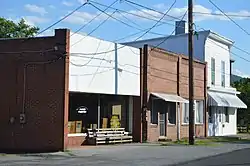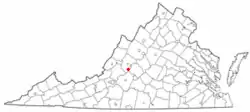Glasgow, Virginia
Glasgow is a town in Rockbridge County, Virginia, United States, at the confluence of the James and Maury Rivers. The population was 1,133 at the 2010 census.
Glasgow, Virginia | |
|---|---|
 McCullough Street in the historic district | |
 Flag | |
 Location of Glasgow, Virginia | |
| Coordinates: 37°37′59″N 79°27′6″W | |
| Country | United States |
| State | Virginia |
| County | Rockbridge |
| Area | |
| • Total | 1.53 sq mi (3.97 km2) |
| • Land | 1.53 sq mi (3.95 km2) |
| • Water | 0.01 sq mi (0.01 km2) |
| Elevation | 738 ft (225 m) |
| Population (2010) | |
| • Total | 1,133 |
| • Estimate (2019)[2] | 1,103 |
| • Density | 722.80/sq mi (279.05/km2) |
| Time zone | UTC-5 (Eastern (EST)) |
| • Summer (DST) | UTC-4 (EDT) |
| ZIP code | 24555 |
| Area code | 540 |
| FIPS code | 51-31136[3] |
| GNIS feature ID | 1494956[4] |
| Website | Official website |
Glasgow has had issues with flooding, notably during Hurricane Camille in 1969. As a result of flooding concerns, the Balcony Falls Dam (just east of the confluence of the James and Maury rivers) was removed in 1973.[5] From 2001 to 2007, the town was known for having at least a dozen fiberglass dinosaur figures along the roadside.[6]
History
German explorer John Peter Salling and his brother Adam were the first Europeans to settle in what is known today as Glasgow around 1741. In December 1742, the Battle of Galudoghson between Iroquois warriors and a company of Virginia militia took place near the confluence of the James River and the Maury River. The militia captain, John McDowell, was killed, along with eight militia soldiers.[7] Between 1760 and 1768, John Paxton II acquired most of the Salling property. Robert, Joseph, and Arthur Glasgow settled in the area in 1768. Glasgow was named after Joseph Glasgow, son of Arthur. Joseph and his wife, Nancy Ellis McCullough, built their home, known as Union Ridge, in 1823.
In 1854 Frank Padgett, a Black slave, drowned while attempting to rescue passengers stranded on a canal boat by the swollen James River. A granite obelisk monument commemorating his death stands in Glasgow's Centennial Park.[8][9]
Glasgow was established on March 5, 1890, when the Rockbridge Company held a drawing of lots. At that time only two houses, Union Ridge and the Salling home, stood in Glasgow, which then had a population of only 20 people. By 1892, the town had paved roads, streetlamps, telephone service and a 200-room hotel, the Rockbridge Hotel. The panic of 1893, however, led to an economic collapse that put the Rockbridge Company out of business. The hotel was abandoned and torn down around 1906. The Virginia Electrical Power Company (VEPCO, now Dominion Energy) built a hydroelectric plant at Balcony Falls in 1915. The plant was in operation until 1969. Citing evidence that the devastating flood of 1969 would not have been as bad if the dam were not there, citizens of Glasgow petitioned to have the dam removed in 1974.[10] Flooding has affected the city numerous times in its history. Since the earliest recorded flood in 1877, the city was flooded in 1936, 1950, 1969, 1972, 1985, and 1995, with the floods of 1936, 1969 and 1985 being the worst.[11]
Geography
Glasgow is located at 37°37′59″N 79°27′06″W (37.633093, -79.451542).[12] Glasgow is about 6 miles east of the community of Natural Bridge, the site of the historic land bridge of the same name.
According to the United States Census Bureau, the town has a total area of 1.5 square miles (3.9 km2), all of it land.
Climate
The climate in this area is characterized by hot, humid summers and generally mild to cool winters. According to the Köppen Climate Classification system, Glasgow has a humid subtropical climate, abbreviated "Cfa" on climate maps.[13] On July 15, 1954, Balcony Falls recorded a maximum temperature of 115 °F (46 °C), which is the highest temperature ever recorded in the state of Virginia.
Demographics
| Census | Pop. | Note | %± |
|---|---|---|---|
| 1910 | 407 | — | |
| 1920 | 376 | −7.6% | |
| 1930 | 507 | 34.8% | |
| 1940 | 938 | 85.0% | |
| 1950 | 810 | −13.6% | |
| 1960 | 1,091 | 34.7% | |
| 1970 | 1,304 | 19.5% | |
| 1980 | 1,259 | −3.5% | |
| 1990 | 1,140 | −9.5% | |
| 2000 | 1,046 | −8.2% | |
| 2010 | 1,133 | 8.3% | |
| 2019 (est.) | 1,103 | [2] | −2.6% |
| U.S. Decennial Census[14] | |||
As of the census[3] of 2000, there were 1,046 people, 450 households, and 296 families living in the town. The population density was 691.9 people per square mile (267.5/km2). There were 494 housing units at an average density of 326.7 per square mile (126.3/km2). The racial makeup of the town was 80.50% White, 16.16% African American, 0.48% Native American, 0.38% Asian, and 2.49% from two or more races. Hispanic or Latino of any race were 0.57% of the population.
There were 450 households, out of which 28.7% had children under the age of 18 living with them, 44.4% were married couples living together, 14.0% had a female householder with no husband present, and 34.2% were non-families. 30.9% of all households were made up of individuals, and 15.1% had someone living alone who was 65 years of age or older. The average household size was 2.32 and the average family size was 2.87.
In the town, the population was spread out, with 23.9% under the age of 18, 7.6% from 18 to 24, 25.0% from 25 to 44, 25.3% from 45 to 64, and 18.2% who were 65 years of age or older. The median age was 40 years. For every 100 females, there were 92.6 males. For every 100 females age 18 and over, there were 87.7 males.
The median income for a household in the town was $28,819, and the median income for a family was $37,292. Males had a median income of $28,235 versus $21,422 for females. The per capita income for the town was $14,093. About 8.9% of families and 14.5% of the population were below the poverty line, including 21.5% of those under age 18 and 15.1% of those age 65 or over.
References
- "2019 U.S. Gazetteer Files". United States Census Bureau. Retrieved August 7, 2020.
- "Population and Housing Unit Estimates". United States Census Bureau. May 24, 2020. Retrieved May 27, 2020.
- "U.S. Census website". United States Census Bureau. Retrieved 2008-01-31.
- "US Board on Geographic Names". United States Geological Survey. 2007-10-25. Retrieved 2008-01-31.
- "History Article's Page". glasgowvirginia.org. Retrieved 19 April 2018.
- "The Town That Time Forgot (Gone), Glasgow, Virginia". RoadsideAmerica.com. Retrieved 2020-08-23.
- Draper, Lyman C. Action at the Galudoghson December 14, 1742; Colonel James Patton, Captain John McDowell and the First Battle with the Indians in the Valley of Virginia; with an Appendix Containing Early Accounts of the Battle. Bowie, MD: Heritage Books, 1995
- Historical marker: "Frank Padget Water Tragedy," Historical Marker Database, April 22, 2022
- Sandi Esposito, "Frank Padget: Hero Batteauman," appetite4history.com, February 22, 2017
- "Maury River Stream Restoration II at Echols Farms, Glasgow, VA," USACE Norfolk District Regulatory/WVRS, June 27, 2016
- "The History of Glasgow," Glasgow town website
- "US Gazetteer files: 2010, 2000, and 1990". United States Census Bureau. 2011-02-12. Retrieved 2011-04-23.
- "Glasgow, Virginia Köppen Climate Classification (Weatherbase)". Weatherbase. Retrieved 19 April 2018.
- "Census of Population and Housing". Census.gov. Retrieved June 4, 2015.
